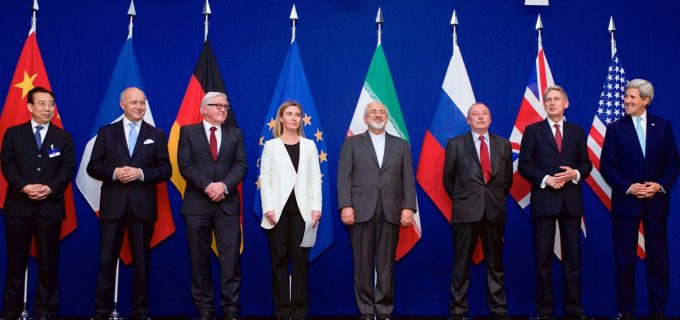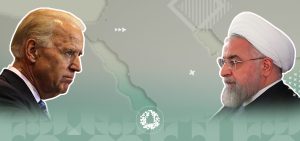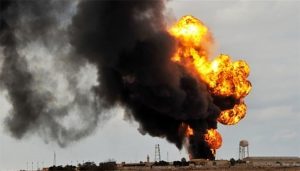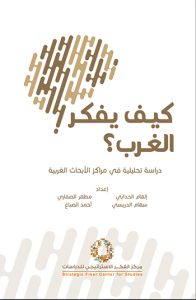Iran’s nuclear deal has been caught in the middle of a complicated stage amid the pressure exerted by US economic sanctions imposed on Iran, military escalation, and targeting economic interests and sea lanes both in the Gulf and the Sea of Oman. This has almost instigated war when Iran shot down US drone and US president stopped a limited military strike at the last minute, which was about to be carried out as a response to the attack.
Iran no longer perceives the nuclear deal as beneficial unless it would reap some fruit, especially economic ones. Attacks on oil tankers in the Sea of Oman may indicate a tendency to getting the Gulf States taste economic pressures or hindering the conclusion of a new nuclear deal.
The assessment of the situation is meant to examine the course of the nuclear agreement, the possibility of maintaining its new format 4 + 1 after the US withdrawal, chances for amending the agreement and its fate, especially between Iran and the United States, and the security impact on the region.
The narrative of the nuclear agreement
Since the US unilateral withdrawal from the nuclear agreement on 8 May 2018, economic pressure on Iran has increased through the US adopting the brinkmanship policy to push Iran to accept the amendment to the nuclear deal. Its clauses won’t be limited to the program, but rather include modifying its behaviour, which threatens the interests of the US and its allies in the region.
The US escalation manifested into strict steps, including totally blocking Iranian oil exports, which Tehran has set as a redline condition according to which it would pursue the agreement. The US position pushed additional sanctions forward involving a 10-percent tax raise on mining and petrochemicals sector. In addition, the Iranian Revolutionary Guards was ranked as a terrorist organization, making it the first official governmental institution to be labeled as such by the US.
On the other hand Iran, confirmed that it would not stand idly by in case Iranian oil vessels were prevented from crossing and took into account the positions of the other signatory countries, giving them a 60-day deadline to actually comply with the terms of the agreement rather than simply talking. Otherwise, Iran would resume nuclear activities, even if it did not officially withdraw from the Nuclear Convention. In turn, these countries refused Iranian threats and stressed their adherence to the agreement as well as the attempts to find a mechanism in order to limit the impact of US sanctions.
Concluding an agreement that would force Iran to restrict its nuclear program and ensure it is both safe and peaceful was not easy to do. However, years of strenuous negotiations, resulted into signing the nuclear agreement commonly known as the Joint Comprehensive Plan of Action, which has lasted for the three-rounds. The first was the Geneva Agreement (Interim Agreement) in November 2013, following which Iran’s nuclear activities were suspended temporarily until a comprehensive agreement is reached. While the second round of the Lausanne Agreement (Framework Agreement) took place in April 2015, and the final round (final agreement) was held on 30 June 2015.
Despite the many gaps in the terms of the general framework of the agreement, it was perceived as a historic step, for it managed to restrict the Iranian nuclear program. The US, European countries, and others highlighted that it had military dimensions that are detrimental to the security of the region in particular and the international economic interests in general. The agreement further established strict controls and oversight safeguards on Iran’s nuclear activities and installations, imposed restrictions on uranium and plutonium enrichment and identified Iranian-owned centrifuges. Meanwhile, Iran resumed economic activity and broke its political isolation, by animating its oil and mineral sector and welcoming foreign investment into its market.
Iran has not been able to reap the fruits of this agreement. Previous sanctions have been reinstated, along with new economic ones imposed by the Trump administration, which considered the deal as weak because it contained many gaps, most notably the skipping decisions on dismantling Iran’s nuclear facilities. Thus, Tehran could possibly own a nuclear bomb in the future as it can resume its nuclear activity once the term of the 10-year agreement is over.
US position
The position of Trump’s administration on the Iranian nuclear file purposely contradicts the position of his predecessor’s administration, Barack Obama. The current US administration often blames Obama for the nuclear deal, believing that it did not include items dealing with Iran’s worrying behaviour which poses threats to the US’s security interests and menaces its strategic allies, through Iran’s armed affiliates in the region.
The United States has not only withdrawn from the nuclear deal, but also imposed economic sanctions on Iran and threatened to extend such penalties to all the countries that might deal with the Iranian authorities. Trump has given a deadline for eight countries which depend on Iranian oil to find another alternative by 2 May, 2019. Meanwhile he called on Saudi Arabia to cover the market’s oil demand. Such step undertaken by US authorities angered the Iranian officials who have threatened to close the Strait of Hormuz, so Iranian ships will not be the only affected vessels.
As soon as the US deadline expired, the decision to implement the US sanctions entered into force, thus tightening the economic grip on Iran.
Data indicate that there are two currents that control the US decision regarding the Iranian file. The first trend is headed by Trump, as his administration’s goal is to reach a new deal with Iran, ensuring that the behaviour of the Iranian regime is amended. The new deal will include 12 items, dealing mainly with three main issues: the imbalance in the nuclear agreement, Iran’s missile capabilities, and the Iranian regime’s conduct that threatens regional security and stability. To achieve this goal, Trump adopted a Maximum Pressure strategy to reach the aspired deal.
This trend tends to solve the Iranian issue diplomatically. In more than one statement, Trump indicated that he did not want a war in the Middle East and was working to bring US troops back from abroad, including his decision in December 2018 to withdraw US troops from Syria, which sparked a political storm in Washington. Thus, the US president is now trying to reach an agreement with Taliban to withdraw from Afghanistan.
The second trend is supported by Secretary of State Mike Pompeo and National Security Adviser John Bolton. This trend is based on the idea of changing the Iranian regime by provoking the Iranian authorities to respond militarily to the US sanctions aimed to besiege Iran both politically and economically, and then ignite a confrontation leading to a war that would weaken the Iranian regime, if not changing it.
Although any military action falls under the jurisdiction of President Donald Trump, especially after the failure of a Senate bill on 28 June, 2019, that suggested revoking the power to wage war from him, there are concerns that Bolton, who is known to be close to Trump, will influence the US president. As such, concerns are heightened by the absence of strong figures in the Trump administration that might counter the Bolton-Pompeo current, following Trump’s removal of powerful figures in his administration, including former U.S. Secretary of State Rex Tillerson, outgoing Defence Secretary James Matisse and White House Chief of Staff John Kelly.
Iran’s position
Despite the pressures exerted by the US administration, Iran continues to adhere to a policy based on patience, deliberately creating dynamism around the file through making statements and sparking controversies from time to time waiting for Trump to get busy with the upcoming elections in the US. After previously refusing to sit at the negotiation table, Iranian officials have declared their willingness to negotiate if the US accepts to grant Iran new prerogatives.
Iran’s insistence on rejecting the amendment of the nuclear deal is based on a number of factors, notably other signatories’ acceptance to stay in the deal, which means the continuity of its executive legitimacy. On the other hand, the International Atomic Energy Agency (IAEA) reports confirm Iran’s commitment to the terms of the nuclear agreement, which strengthens Iran’s position in its refusal to enter into new negotiations for its nuclear project.
Despite threats made by Iran to restore its nuclear activities and allocating a 60-day deadline for other signatories to comply with the terms of the agreement, it has not withdrawn from the deal so far. This indicates that the nuclear agreement might possibly maintain its current form, i.e. 4+ 1. Thus, the factor that might reinforces the possibility to maintain the current deal is Iran’s ability to manoeuvre for a longer period of time under the pressure of the US sanctions, drawing on the experience of 40 years of enduring economic pressure and sanctions, in addition to its ability to mobilize controversial files in the region through its military and sectarian capacities.
On the other hand, Iran’s geostrategic location plays a pivotal role in enabling it to pursue its patience policy until new variables emerge for the US administration that may be useful for the survival of the nuclear agreement in its current form or in a new format that is not very different from the previous version. Hence, Iran is the biggest beneficiary of this version of the deal, as it strengthens its political and economic presence and endorses its military influence in many of the region’s significant files.
The position of other signatories to the nuclear deal and the Gulf States
Although one year has passed since the US withdrawal from the nuclear agreement, no other signatories have withdrawn. On the other hand, the signatories did not stop trying to find a way out of the US sanctions imposed on Iran. Hence, despite the commitment shown by the signatories to the agreement, it does not seem that any country has a clear strategic plan that could be a satisfactory alternative to Iran, which prompted the Iranian authorities to use a threatening discourse.
Despite the US accusations against Iran following the bombings in the Gulf of Oman after the end of the US deadline for the eight signatories, which were exempted from sanctions for the import of Iranian oil, no signatory country has adopted the US charges, except Britain, which maintained the US anti-Iran discourse.
While the Russian and Chinese positions were opposed to the US position on the nuclear issue, the European Union, notably the three signatories Britain, France, and Germany, is working to ease the escalation in the Gulf region and try to meet the obligations of the agreement according to Iranian demands.
In accordance with Iran’s demands, in a statement issued on 28 June 2019, following a meeting in Vienna, the EU confirmed that Britain, France and Germany have a special trade mechanism with Iran, which is ready and effective, in order to avoid US economic sanctions. For his part, Iran’s Assistant Foreign Minister for Political Affairs, Abbas Arajisaid on Friday that the European proposals to promote trade with his country is a step forward, but probably not enough to prevent Tehran from gradually withdrawing from its nuclear agreement with major powers.
The Gulf countries have all affirmed the need for a peaceful solution as they were the most affected parties by the recent escalation in the Gulf region. Thus, Saudi Arabia’s stance is more open to criticising Iran’s hostile policies. In this context, the Saudi Kingdom has organized two emergency summits, the Gulf Summit and Arab League Summit, following the Islamic Summit on 27 Ramadan (1 June, 2019), with the aim of condemning Iran’s Houthi affiliate in Yemen, which intensified its attacks on Saudi interests there.
Conclusion
The US position remains ambiguous, if not ambivalent about the Iranian file. After retreating from the military strike at the last moment, Trump is no longer referring to the possibility of dialogue between Washington and Tehran, stressing that the US is not willing to go through a war that may have disastrous consequences on the region.
Trump’s administration has resumed a policy of economic pressure based on imposing of sanctions on Iran’s Supreme Leader Ali Khamenei, Foreign Minister Mohammad Javad Zarif, and leaders of the Islamic Revolutionary Guard Corps (IRGC), which Iran has considered as a step towards blocking the diplomatic path between Washington and Tehran.
The US current strategy was disclosed after the US administration chose not to respond to the IRGC’s attack on its drone, followed by Trump’s subsequent assurances that the US has no real interest in the Strait of Hormuz. Thus, the US president stressed that the US current role is limited to protecting the interests of other countries in the strait who must pay the bill of such protection. Trump’s position might be a sign that the United States no longer cares about the stability of the region to make concessions, so it is clear that the impact of the US economic escalation against Iran has its security implications on the region.
Iran and the rest of the signatories of the nuclear agreement are likely to be committed to the deal in future, provided that the other signatory states are serious about taking procedural steps to ease US sanctions on Iranian economy and maintain Iran’s ability to export oil according to the European trade mechanism.
However, the possibility of holding new negotiations between the US and Iran is very probable if it is not underway in secret. Yet, the chances of these talks’ success depend on the ability of both parties to make concessions. Some of these concessions will be at the expense of the countries of the region, according to the principle of exchanging services between the US and Iran in the region. Indeed, the US cannot exert military and economic influence without the existence of a security menace that threatens the interests of its allies in the region.







